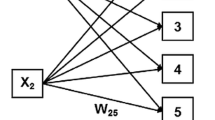Abstract
Many studies on learning of fuzzy inference systems have been made. Specifically, it is known that learning methods using VQ (Vector Quantization) and SDM (Steepest Descend Method) are superior to other methods. We already proposed new learning methods iterating VQ and SDM. In their learning methods, VQ is used only in determination of parameters for the antecedent part of fuzzy rules. In order to improve them, we added the method determining of parameters for the consequent part of fuzzy rules to processing of VQ and SDM. That is, we proposed a learning method composed of three stages as VQ, GIM(Generalized Inverse Matrix) and SDM in the previous paper. In this paper, the ability of the proposed method is compared with other ones using VQ. As a result, it is shown that the proposed method outperforms conventional ones using VQ in terms of accuracy and the number of rules.
Access this chapter
Tax calculation will be finalised at checkout
Purchases are for personal use only
Similar content being viewed by others
References
Gupta, M.M., et al.: Static and Dynamic Neural Networks. IEEE Press, Hoboken (2003)
Cordon, O.: A historical review of evolutionary learning methods for Mamdani-type fuzzy rule-based systems, designing interpretable genetic fuzzy systems. J. Approx. Reason. 52, 894–913 (2011)
Miyajima, H., et al.: SIRMs fuzzy inference model with linear transformation of input variables and universal approximation, advances in computational intelligence. In: Proceedings of the 13th International Work Conference on Artificial Neural Networks, Part I, Spain, pp. 561–575 (2015)
Kishida, K., et al.: A self-tuning method of fuzzy modeling using vector quantization. In: Proceedings of the FUZZ-IEEE 1997, pp. 397–402 (1997)
Kishida, K., et al.: Destructive fuzzy modeling using neural gas network. IEICE Trans. Fundam. E80–A(9), 1578–1584 (1997)
Kishida, K., et. al.: A learning method of fuzzy inference rules using vector quantization. In: Proceedings of the International Conference on Artificial Neural Networks, vol. 2, pp. 827–832 (1998)
Fukumoto, S., et al.: A decision procedure of the initial values of fuzzy inference system using counterpropagation networks. J. Sig. Process. 9(4), 335–342 (2005)
Pedrycz, W., et al.: Cluster-centric fuzzy modeling. IEEE Trans. Fuzzy Syst. 22(6), 1585–1597 (2014)
Miyajima, H., et. al.: Fast learning algorithm for fuzzy inference systems using vector quantization. In: International MultiConference of Engineers and Computer Scientists 2016, Hong Kong, vol. I, pp. 1–6, March 2016
Martinetz, T.M., et al.: Neural gas network for vector quantization and its application to time-series prediction. IEEE Trans. Neural Netw. 4(4), 558–569 (1993)
Miyajima, H., et al.: An improved learning algorithm of fuzzy inference systems using vector quantization. Adv. Fuzzy Sets Syst. 21(1), 59–77 (2016)
UCI Repository of Machine Learning Databases and Domain Theories. ftp://ftp.ics.uci.edu/pub/machinelearning-Databases
Miyajima, H., et al.: Performance comparison of hybrid electromagnetism-like mechanism algorithms with descent method. J. Artif. Intell. Soft Comput. Res. 5(4), 271–282 (2015)
Author information
Authors and Affiliations
Corresponding author
Editor information
Editors and Affiliations
Rights and permissions
Copyright information
© 2016 Springer International Publishing AG
About this paper
Cite this paper
Miyajima, H., Shigei, N., Miyajima, H. (2016). The Ability of Learning Algorithms for Fuzzy Inference Systems Using Vector Quantization. In: Hirose, A., Ozawa, S., Doya, K., Ikeda, K., Lee, M., Liu, D. (eds) Neural Information Processing. ICONIP 2016. Lecture Notes in Computer Science(), vol 9950. Springer, Cham. https://doi.org/10.1007/978-3-319-46681-1_57
Download citation
DOI: https://doi.org/10.1007/978-3-319-46681-1_57
Published:
Publisher Name: Springer, Cham
Print ISBN: 978-3-319-46680-4
Online ISBN: 978-3-319-46681-1
eBook Packages: Computer ScienceComputer Science (R0)




